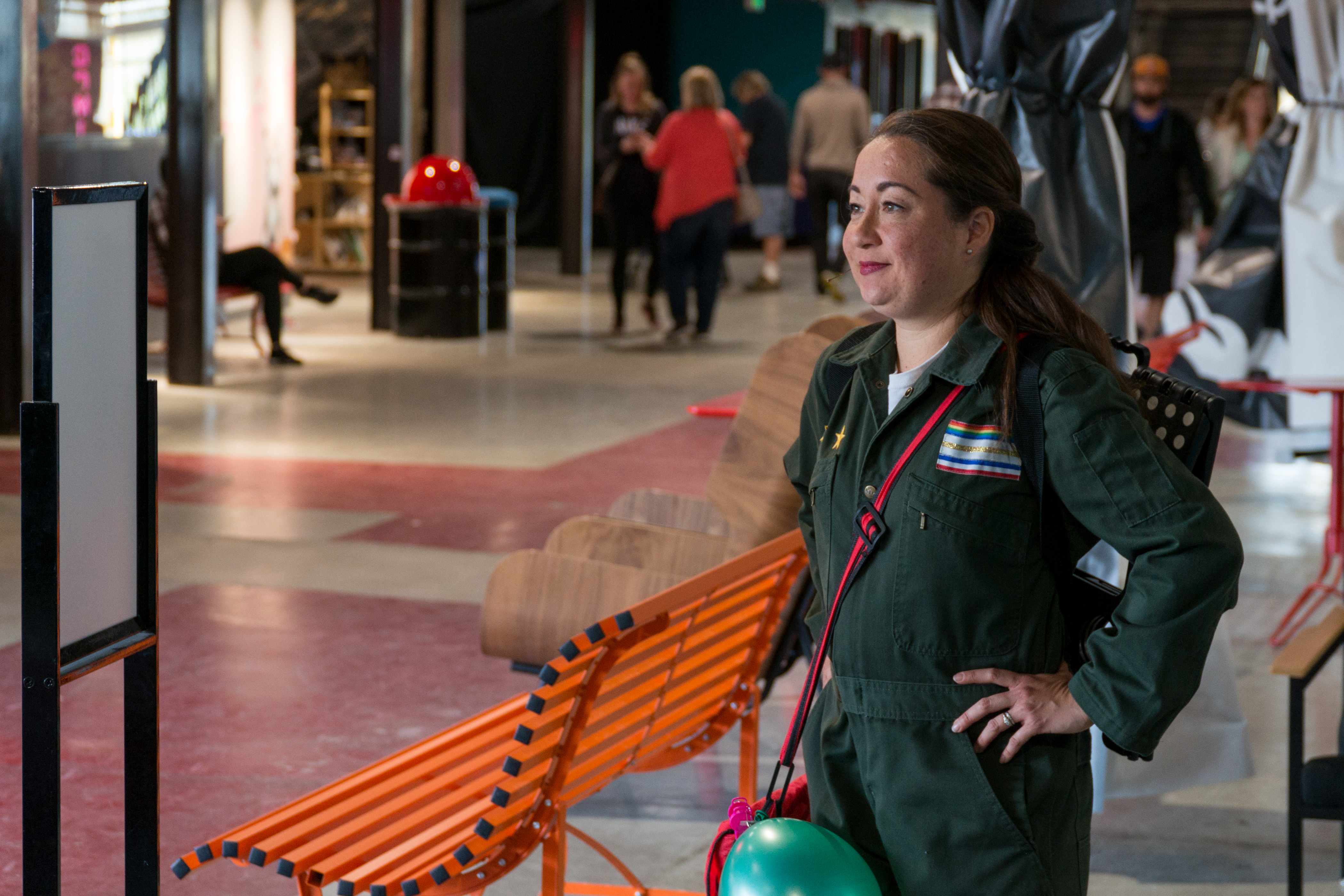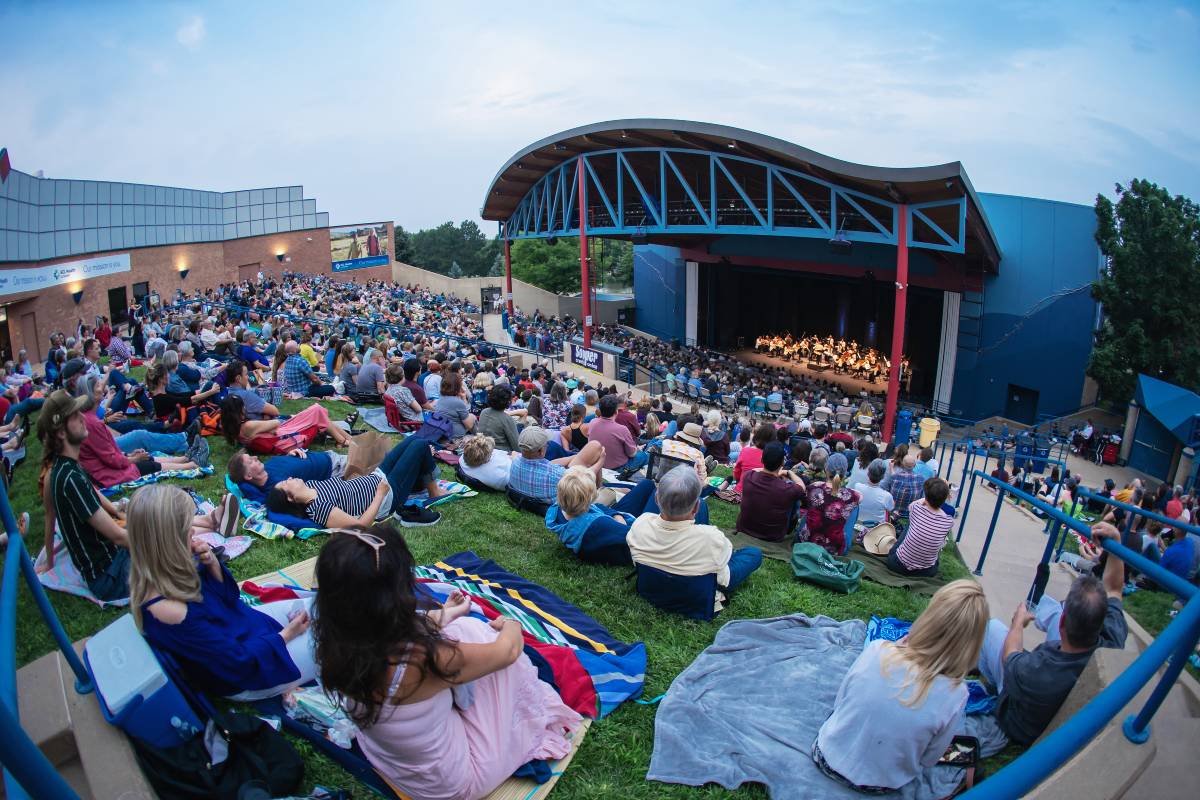
Stanley Marketplace.
Packed inside was a balloon, a plastic red rose, 3D glasses and a brown paper bag with a hole cut in it, among other items. I was one of 45 people to travel to the “Lost Dimension” that afternoon, a dimension “just like ours, but not.” The fact that I was given this kit did imply this is something to be survived. Though, I soon learned, my ego would be put on the line, not my life.
Linda Klein, a member of Denver comedy trio A.C.E. — Klein is the “A,” the American, and her partners are Canadian and English — accompanied me on this journey. With her two colleagues, Klein created the latest interactive theater undertaking by Off-Center, the idiosyncratic arm of the Denver Center for the Performing Arts focused on less conventional theater programming.

Klein described “Travelers of the Lost Dimension” as “adventure comedy,” a style that A.C.E. has been at for about 18 years.
Part of the adventure happens “sort of subconsciously,” Klein said, as the audience is encouraged to take “a courageous step and do something that’s a little out of their comfort zone — in the public sphere.”
First stop was “Mission Control,” where a woman, who introduced herself as “Taylor T. Wilson,” instructed me to blow up my “personal atmospheric tank” (aka the balloon in my survival kit). She stressed the importance of not tying a knot so as “to have easy access to the air, should it become necessary.” She then walked me, and a few other fellow travelers, through how to secure our tanks to ourselves.

As the mission briefing began, three self-described scientists explained that there’s a rift in the space/time continuum under the Stanley Marketplace, which, on this particular day, teemed with people browsing the market’s artisanal shops and restaurants.
“This is the fun part of the show,” Klein leaned over to say to me. “The audience is seated in chairs. They want to be an audience. It’s almost normal. But they’ve had to blow up a balloon and they’re getting that feeling this is not exactly what they expected. They’re madly trying to work it out in their heads.”
The “Trans-Dimensional Device” would be our conduit to this misplaced dimension. Taylor, our official guide, led the travelers through what appeared to be an industrial access way in a back hallway, toward the TDD.
“[The scientists] built their Trans-Dimensional Device in a place that would be a little bit away from traffic patterns, so no one would accidentally stumble into it,” Klein announced with her sunny disposition as we began to pack inside.
It was dark and tight in there. I reached into my survival kit and pulled out the aforementioned 3D glasses as Taylor told us to put on our “space-tacles.” The effect was disorienting, but luckily travel through this rift was not a lengthy trek.

I asked Klein where this dimension is and why it’s considered lost.
“The Lost Dimension is a place where anything can happen,” came the retort. “But since it’s a fanciful place, we have yet to really define the science specifically about where it exists or how exactly we get there, because it’s comedy.”
Arriving at the Lost Dimension, Taylor warned everyone about the dangers of “rift worms,” which, she noted with all practicality, “have developed a taste for human.” But, she added, these tube-like creatures are sound sleepers and, if we tip-toe, we should all be OK.
I studiously followed these instructions and tiptoed outside the Stanley, around the rift worms and back indoors.
What followed was a series of vignettes within a larger, loose narrative about Taylor trying to find her father, a traveler to the Lost Dimension more than a decade ago. I encountered a seven-foot-tall oracle named Calandra, who sourced questions from my fellow dimensional tourists to ask two prophets, whose heads appeared inside a crystal ball. From there, Taylor guided everyone to an art therapy session, a Olympic-like event featuring pairs shopping cart dancing and a life-size video game that involved throwing small balls at people in deer costumes with targets on their bodies. Each scene was intended to take us deeper into the Lost Dimension, and I found the clues of how to uncover its mysteries in my survival kit.
Besides being an apparent dimensional nexus, the Stanley Marketplace is also the former site of aerospace company Stanley Aviation. Founded by aviation pioneer Robert Stanley, Stanley Aviation was perhaps best known for its design and production of ejection seats in the 50s and 60s. Klein said that history inspired the show.
“We had a feeling of 1950s, 60s science fiction when we first came into the building,” she said. “So we took that tone with the show and created a title that was sort of based on a B-rated comic book kind of thing.”
Much of the show I attended happened in very public spaces.
“It’s really two levels of observation happening. It’s the participants or the travelers and everyone else in the space watching the explorers,” Klein said.

Responses from the general public ran the gamut, from curiosity about why there was a group of people with balloons attached to them tiptoeing about, to laughter and even participation — on the latter point, a young girl’s birthday party happened to occupy the same space as the oracle. That happy coincidence allowed her to ask a question of her future as told by the prophets I mentioned earlier.
Klein and her colleagues have a very simple objective with this show. Whether people pay for a ticket to see “Travelers of the Lost Dimension” or they’re at the marketplace to buy an ice cream, Klein hopes they walk away with a new perspective.
“As adults, we often leave all the playing to kids,” she said. She added that the playfulness and lightheartedness of the show pushes people to use their imaginations and “value those moments of spontaneity, laughter and not taking themselves too seriously.”
“Travelers of the Lost Dimension” certainly required some playing along.
Travelers of the Lost Dimension plays at the Stanley Marketplace through May 21, 2017.
Related: Immerse Yourself In Denver Center's 'Sweet & Lucky' With These Photos









